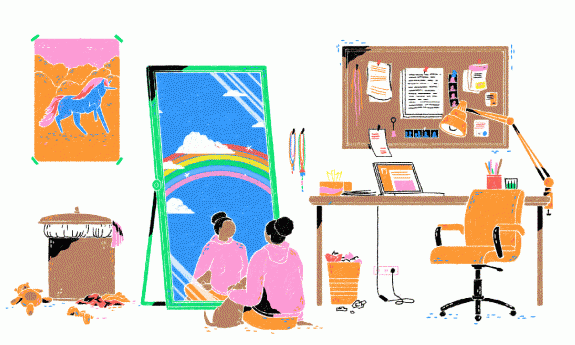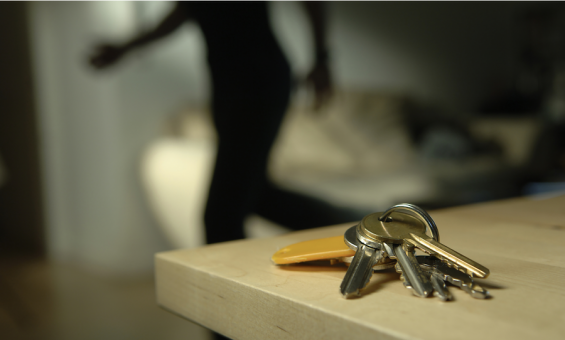
Some advice on coming out
“In a perfect world, I believe that members of the LGBT community shouldn’t have to come out,” says New York high school student Amanda Gundel in a 2018 TEDx talk. “We should all be able to co-exist in our little bubbles and go out and do our own things.”
Unfortunately, we don’t yet live in that world, and LGBTQ+ people continue to face the pressure to come out.
What’s more, coming out isn’t a one-time act. After you come out for the first time, you’ll probably have to keep coming out to new people — new friends, new coworkers, new family members — for the rest of your life. This can feel overwhelming, so it’s crucial to take it one step at a time.
While there is no simple formula, there are people in the queer community who are glad to share their experiences as a guide.
Below, Gundel, now a writer and student at Binghamton University in New York, and queer therapist Daniel Tehrani, whose NYC psychotherapy practice at the Institute For Human Identity focuses on gender, sexuality, trauma and substance abuse, provide some insight:
1. Sit with yourself
We live in a society where heterosexuality is the norm. In fact, most people you meet probably assume you’re heterosexual and also cisgender (your gender identity matches the biological sex you were assigned at birth).
Queerness is an exception to these norms, so queer people can often end up questioning themselves and wondering how they fit in. In the coming out process, taking time for self reflection is important because it gives you the opportunity to define yourself on your own terms.
“The Q, or Questioning, part of LGBTQIA is so important, because we are all ‘Q’, or Questioning before we are firmly gay or lesbian, etc.,” explains Tehrani. “Whether it was for one second or several years, there was a moment where we thought, ‘I don’t know.’ That’s in part due to the fact when we grow up, we’re told we are straight, without being able to really think ‘Wait, what? Am I actually straight?’”
So step one is to sit with yourself. Consider who you are outside of all your social, cultural and familial expectations. In a world that is quick to tell us who we are and who we should love, reconsidering and reclaiming your own identity can be a radical act of self love. Ask yourself what your truest wants, needs and feelings are.
2. Come out to yourself
Stand in front of a mirror, recommends Gundel, and “look into your own eyes and come out to yourself.”
This might sound unnecessary — isn’t the whole point of coming out to be out to other people in the world? Gundel explains: “If you can’t bring yourself to say it when no one is around, there’s no way you’ll be able to go further than this step.”
Maybe you’ve known you are trans since preschool. Maybe you started to question your sexuality in your 60s after your heterosexual marriage ended. Regardless of where you are in life, the most important person to come out to is always yourself. Start there, and hold yourself with patience and kindness. “Be patient with it, and don’t rush it,” says Tehrani.
3. Come out to a pet or a plant
Next, practice coming out to something that lacks the ability to judge, such as your dog, cat or plant.
“The great thing about coming out to your pet is they really couldn’t care less; your pet will still want affection from you,” says Gundel. “No matter what you tell them, it won’t affect them in the slightest.”
Tehrani agrees. He says, “If you have a cat, dog or goldfish and say to it, ‘I’m gay,’ it’s still gonna be like, ‘OK, do you want to cuddle? Do you want to give me a treat? Do you want to go for a walk?’ They really don’t care, which is something our human family members could learn from.”
4. Find a support system
Now that you and your non-human companions know you’re queer, it’s time to find your crowd.
“This is the most important step, and I cannot stress this enough — you must find people around you who will love you, regardless of your sexual orientation or your gender,” says Gundel. “It’s toxic to be around people who will not accept you. Get away from those people, if possible, and surround yourself with others.”
Of course, finding your crowd — the strangers who become friends and eventually form your chosen family — is not always easy. Don’t feel discouraged if the people you reach out to don’t immediately welcome you, says Tehrani. He explains, “People who are members of the queer community may have their own difficulties and traumas, and they’re trying to figure things out just as you are.”
He suggests you search for local events held by LGBTQ+ organizations, follow queer activists on social media (you can find them via hashtags or through queer celebrities’ accounts), and if you’re a student, join your school’s Gay Straight Alliance (GSA) to connect with your peers and access resources.
On the value of finding your crowd, Tehrani notes, “Coming out is kind of a dance with shame — ‘I have the shame of being a person who represents a marginalized community that is literally targeted by governments, by society, by religious organizations, by peers, by bullies. I’m a person with a target on my back, and I’m ashamed of this.’”
His advice: “A really good way of reducing shame is by knowing a lot of queer people, loving them and thinking, ‘OK, if they’re not ashamed of being who they are, why should I? They’re not that different from me. I love them, they’re so important to me, and I would never want that pain for them.’”
It’s sometimes easier for us to empathize with others than with ourselves. By befriending, supporting, accepting and loving people in the queer community, you’re also telling yourself that you’re worthy and deserving of friendship, support, acceptance and love.
5. Come out to someone in your crowd
After you’ve found your crowd, the next step is to open up to them about your sexuality or gender identity. During the coming out process, your physical and emotional safety should remain your priority, and revealing yourself to someone in this group should keep you safe.
6. Come out to someone outside your crowd
If and when you come out to someone who’s outside your crowd, both Tehrani and Gundel suggest you take your time to decide whether it’s the right person and the right time to say something. Sound them out: Ask them about their current feelings on LGBTQ+ rights, or mention a queer celebrity who’s posted something supportive on social media. This can help you decide who to come out to first.
Again, your physical and emotional safety should be in the forefront of your mind. Tehrani emphasizes that you should come out only when it’s safe for you. “There’s a significant risk that’s associated with coming out, and so it’s really important to assess whether you’re safe to do so before you do,” he says. “I have to say that safety probably takes priority over coming out, even if it means your delaying it for several months until you have a place to stay that’s safe or you have enough money in case you are kicked out of your home.”
Research from the University of Chicago found that LGBTQ+ young adults have a 120 percent higher risk of reporting homelessness, compared to youth who identify as cisgender and heterosexual. As Tehrani notes, “coming out for someone with more resources is very different versus coming out for someone with no resources.” Additionally, people of all ages who come out risk being ostracized, rejected or judged by others in their communities, which threatens their emotional safety.
Once you’ve decided who you want to come out to, prepare yourself for the worst. “Let your friends — the people within your crowd — know what you’re doing, and think of a place you can go to in case things go really badly,” says Tehrani. “Have the resources on hand in case you feel as though you’re in emotional danger — such as the phone number of a friend, your therapist or a loved one.”
Just so you know, it took Gundel about 2 years to go through these six steps; it might take someone else 20 years. It’s possible that as you explore your sexuality and gender expression throughout your life, your identity will continue to evolve, and you may decide at some point to come out with a different identity.
“Our sexualities are just like our personalities; when you were 10, you weren’t the same person that you are at 20, 30, 40,” says Tehrani. “Our sexualities can change and develop too. They are very fluid. So it can be quite uncomfortable to have to come out with a different identity several times. But it is OK.”
He adds, “I don’t want to say ‘It gets better’ because I think it’s a little overused, but it does get better. Keep pushing, don’t lose hope, and keep looking towards a future where you can be yourself. There is nothing more meaningful in this world than feeling safe enough to just be yourself.”
Watch Amanda Gundel’s TEDxWCMephamHigh Talk here:
ABOUT THE AUTHOR
Paula Carrizosa is a writer and media fellow on the TEDx team at TED.
This post was originally published on TED Ideas. It’s part of the “How to Be a Better Human” series, each of which contains a piece of helpful advice from someone in the TED community; browse through all the posts here.




